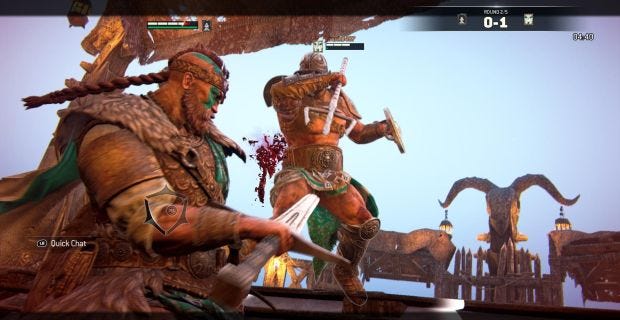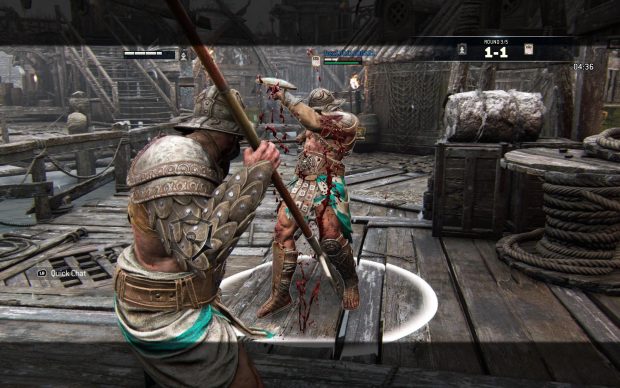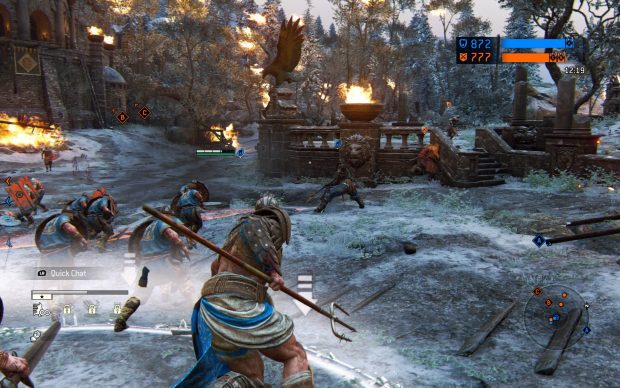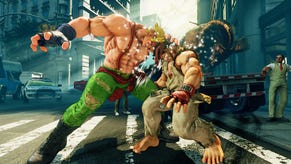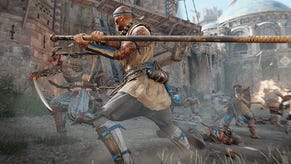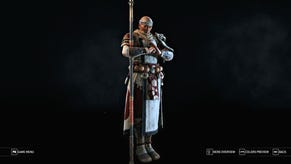Has For Honor been improved by its updates?
Update Night
Update Night is a fortnightly column in which Rich McCormick revisits games to find out whether they've been changed for better or worse.
The burly girls and boys of For Honor might make a big show of their bravery, grunting and screaming their way to ignominious defeats and glorious victories, but their brutal hand-to-hand fights aren’t actually for hono(u)r. They’re for “Renown Points,” for “Steel,” for “Reputation,” for “Feats,” for “Salvage,” and for “War Assets.” They’re for a whole mess of currencies and awards that, six months after release, make For Honor feel as cluttered and clumsy as it was at launch.
This is a Ubisoft game, after all, so unless Hono(u)r can be capitalised, counted in blocks of 100, and displayed on an overly busy user interface, it’s hard to see where it would fit. There’s so much superfluous stuff going on already, with an overarching war map, TV-like seasons of conflict, and a complicated upgrade system obfuscating the core of the game: a historically improbable three-way thunderdome between samurai, knights, and vikings.
That’s combined with a still-shaky online experience that forces players to sit in lengthy matchmaking queues before kicking them out of matches and back into menus for five-minute-long load times. I was kicked out of every third game of the four-on-four Dominion mode, a result of host migration, a lack of players, or an apparently vengeful war god just deciding my time was up. About half the time I tried to initiate another game, For Honor simply told me that matchmaking was unavailable, doing me dirty as I wasted five, 10, 15 minutes just trying to find some people to kill. When I did get into matches, losing players would bounce as soon as the score slider made it clear their team was going down: turning tail and deserting the field of battle to avoid sitting through an interminably long after-action report.
Honor was also in short supply at Ubisoft’s first official tournament for the game, where player SB.Alernakin cheesed his way to $10,000 on the back of one unblockable attack. Alernakin (real name Jakub Palen) took advantage of so-called “unlock tech,” a frowned-upon technique that relied on him disabling his character’s lock-on function during an attack to ensure his foe was unable to block its swing.
His win at the tournament earned Palen a telling-off from For Honor’s creative director, and a hint that the company would patch unlock tech out of the game. A month later, and the company has made at least some good on its threat, releasing a patch that has removed the specific exploit Palen was using. But for new players and battle-scarred veterans alike, the wider balance of the game still feels off.
Part of that’s down to recent entrants onto the field of imaginary combat. Of the four new characters released as DLC since the game’s launch, at least two feel significantly more powerful than their peers. The Centurion is a king-of-all-trades, an all-rounder whose main weakness — his short range — is unpicked by a tasty jumping charge attack. He’s over-represented in the game’s online multiplayer, both in four-on-four and one-on-one modes, and already treated with disdain by the YouTubers and guidemakers who’ve stuck with For Honor since launch.
I clicked quicker with the Gladiator, however, a buff trident-wielder with the stamina of a marathon runner and the exposed nipples of a man who kills for a living. I memorised a lovely combo that saw me duck to the side of a strike, stun my opponent with my tiny shield, rake them with my trident, and then spear them in the chest for extra bleed damage. For extra prickitude, when performed near the edge of a level, that spearing could be used to direct foes, flipping them to their doom. It felt great at first, landing this chain of strikes, but I began to rely on it almost entirely, setting up for another attempt rather than digging deeper into my bag of stabs.
When I started getting matched against enemies who could catch up to my single combo, I reverted back to basics, hammering the light attack button to jab them with staccato stabs. That too worked embarrassingly well, pinning both slow and speedy enemies in place while I whittled away at their health bars, comfortable in the knowledge that the Gladiator’s skills made me seem much better at the game than I actually was.
The Highlander, on the other hand, feels like a man without a home. He’s big and slow, but his health pool doesn’t seem to reflect his heft, and his claymore doesn’t do the kind of damage you might expect from a six-foot chunk of sharpened steel. He’s built to be situational, allowing players to flip stance from a standard defensive look to a risky offensive approach, but even his biggest overhand strikes don’t put out enough punishment to justify his use. Players who do use him right seem to rely on a single spin move that can chain into a healthy combo, but if you can duck that initiator, you’re laughing.
And that’s one of the problems with For Honor’s fighting game aspirations: it’s too easy just to dial in a few combos and throw them out until they work. That’s the same both for low-level scrubs and tournament winners alike, and it removes much of the rock-paper-scissors (you meant “shotgun?” - Ed) of other competitive fighting games. In Street Fighter, a whiffed attack means you need to try something else. In For Honor, where some combos remain silly good, it just means you need to keep spamming it until it does connect.
That’s especially true in Dominion mode — a four-on-four battle for control points. Any semblance of honourable combat is lost in this madcap gankfest, where my one-on-one bouts were almost always interrupted by another player plunging a blade into my back. Blocking, parrying, and For Honor’s other more nuanced systems go out of the window in these games, the screen and battlefield far too busy with UI elements and AI soldiers to allow for thoughtful tussles.
For Honor’s Revenge system is built to redress the balance in one-versus-many fights, but can be similarly frustrating for the gankers, granting solo fighters superhuman powers after a few successful blocks. Ubisoft has tweaked and toyed with the rate of Revenge buildup, as well as its impact, but good players can still abuse it for less-than-honourable gains. Playing as a super-flimsy Shinobi, I successfully got the jump on a plate-armored Warden as he tangled with my buddy, pulling him down to the last rectangle of his life bar; only to have said Warden remember how angry he was about being ganged up on, and swing his suddenly superpowered sword once to cleave us both in half.
It might come from a place of fairness, but it's not a fun system. Revenge makes For Honor’s combat feel fuzzy, producing matches where players can’t predict the kind of damage they’re capable of putting out or taking in. It’s made fuzzier still when Dominion matches also take a player’s armour, weaponry, and shield into account — upgradeable items that reward long-term fighters with buffs to stamina, attack power, and other stats. Coming back to the game now, six months after launch, some of my characters were palpably worse than their veteran equivalents on the opposing team, making fights feel even more unfair.
Fortunately, there’s more honour to be found in the game’s one-on-one duels, where stat-altering items are ignored. This mode brings For Honor closest to a proper fighting game — or at least, to Dark Souls’ multiplayer fight clubs. There’s tension in the moment before the clash, consideration in how best to employ the game’s tri-directional blocks and attacks, and the time and space to employ your chosen character’s core strengths. So much of For Honor’s area-conquering and gear-collecting metagame is built around Dominion mode, but it’s the duels that deliver on the promise of its gloriously silly “what if…?” fights. Despite the weight of upgrade systems to codify your character development, it's the esoteric, Dark Souls-ian sense of personal progression that makes For Honor's best matches come close to greatness. I came out of them with my heart racing, knowing better how to combat speedy Shinobi, or when to go for a parry attempt against a Warden's telegraphed overhand swing.
Ubisoft seem to know that, centring tournaments around mano-a-mano combat. It’s generally easier to get — and stay — in a game too. Because you’re only relying on one player rather than seven, there are fewer problems with disconnections, drops, and other online issues. They’re not gone altogether though: I fell out of a number of duels half-way through, and the shaky player hosting solution meant I wasn’t always sure whether I was failing blocks because of my internet connection, or because of my general shitness.
The promised move to dedicated servers may reduce some of these serious stabbing pains with the online experience, but there’s a wider wobblyness still inherent in For Honor. Ubisoft — as is their style — have piled more systems upon the edifice since launch in an attempt to shore it up, but they too often distract from the core of the combat system, which is at its best in its most basic, one-on-one form. Like its crumbling and besieged castles, For Honor still has some structural problems it needs to address before I would recommend moving in.
